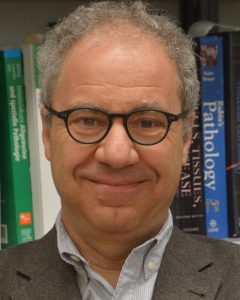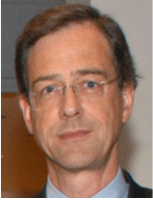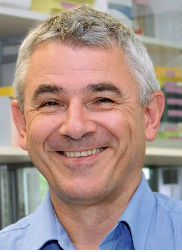Organizer: A. Bikfalvi, INSERM U1029
Flyers :
January-june 2017
October- december 2017
 |
Christian Stockmann (PARCC, Paris)January 18, 2017 – 2:30pm |
Microenvironment, inflammation, Cancer |
|
 |
Jean-Philippe Girard (IPBS, Toulouse)February 16, 2017 – 11h am |
Tumor vasculature, chemokines |
|
 |
Timothy Thompson (Institute for Molecular Biology, Barcelona)March 9, 2017 – 11am |
Ubiquitin system and cancer |
|
 |
Simone Niclou (Norlux laboratory , Luxembourg-Bergen)May 19, 2017 – 11am |
Glioma/Glioblastoma heterogeneityThe seminaire deals with tumor and stroma determinants that are involved in tumor heterogeneity as well as with the role of the micoroenvionment in glioma expansion. |
|
 |
Gabriele Bergers (UCSF, San Francisco and University Leuven)June 9, 2017 – 11am |
Tumor cell invasion and angiogenesis in glioma |
|
 |
Nicolas Aceto, University of Basel, Cancer Metastasis LabOctober 20, 2017 – 11am |
|
Cancer patients that develop a metastatic disease are currently considered incurable. Mainly, this is due to a limited understanding of the molecular mechanisms that characterize the metastatic process, and the lack of effective metastasis-suppressing agents. The metastatic cascade begins with primary tumor cells entering the blood circulation, and it is followed by their extravasation at distant sites, where they form proliferative metastatic lesions. Cancer cells in circulation are referred to as circulating tumor cells (CTCs), and their isolation has been hampered for many years by technological constraints. However, CTC isolation and characterization has recently become possible, and it has revealed highly unexpected features of the metastatic process. For instance, using a combination of microfluidic technologies, single cell sequencing, molecular and computational biology, we understood that CTC-clusters, rather than single migratory CTCs, are highly efficient metastatic precursors in breast and prostate cancer. Our research now focuses on the identification of the vulnerabilities of CTC-clusters, with the ultimate goal of developing metastasis-suppressing agents. |
|
 |
Michel Tremblay, Goodman Cancer Center McGill University, MontrealDecember 14, 2017 |
Deciphering the function of protein tyrosine phosphatases (PTPs) in CancerAs PTPs serve as controls for each other functionally and experimentally, my laboratory chose to work simultaneously on several of these enzymes. Our research revolves around the following five PTPs; PTP-PEST (PTPN13), PTP1B (PTP-N1), TC-PTP (PTPN2), the LAR-PTPs subfamily and especially PTP-sigma (RPTPS), and the oncogenic PRL2 (PTP4A2). These enzymes remove the phosphate moiety from tyrosine and were considered tumor suppressor genes counteracting the protein tyrosine kinase family, of which over 70% have been associated with oncogenic activities. Yet, we have clearly shown that many PTPs are as oncogenic as they are tumor suppressors. Using gene knock-out technologies and other molecular approaches our laboratory generated various mouse models and assays for all these enzymes and demonstrated their functions in cancer and also in other human diseases. Data regarding these different models and research projects will be presented in this talk. |
|
Gertraud Orend ( INSERM U1109 – MN3T, Université de Strasbourg, FMTS, France )February 2, 2018 – 10h30am |
|
The extracellular matrix molecule tenascin-C promotes metastasis by several stromal and tumor cell autonomous mechanisms.The extracellular matrix molecule tenascin-C is highly expressed in cancer tissue where its abundance correlates with metastasis and worsened patient survival (1). We had developed the first stochastic tumor model with abundant and no tenascin-C, and demonstrated that tenascin-C promotes lung metastasis and multiple steps on the road to metastasis such as survival, migration, the angiogenic switch and non-productive angiogenesis through Wnt signaling employing repression of the Wnt signaling inhibitor Dickkopf 1 (2, 3). Tenascin-C may impact on tumor and stromal cells residing in so called tenascin-C matrix tracks in an autocrine (4) as well as paracrine manner (5). Metastasis is a major cause of death in patients with cancer, and a better knowledge of the molecular mechanisms underlying metastasis may improve patient survival. Vascular invasions are prognostic factors for tumor metastasis, however the cellular and molecular organization of vascular invasions is not well characterised, nor is it clear how these features drive metastasis. We defined a universal cellular anatomy of vascular invasions and identify tenascin-C as a key component of these blood vessel invasions in cancer. We also demonstrate in a transgenic murine MMTV-NeuNT model of metastasis, engineered to control tenascin-C expression levels, that tenascin-C promotes endothelialization of vascular invasions, tumor cell survival, and dissemination of circulating tumor cells into lung parenchyma. We further show that tenascin-C induces epithelial-to-mesenchymal transition through TGF-β signaling promoting migration and survival (Sun et al.,submitted). Tenascin-C can also trigger tumor cell-autonomous signaling mechanisms explaining how tenascin-C promotes cancer cell migration. We demonstrate that as soon as tenascin-C is expressed it has an impact on tumor cell behaviour. In a murine xenograft model of advanced human osteosarcoma we demonstrated that tenascin-C and its receptor integrin α9β1 are essential for lung metastasis of tumor cells. We determined that activation of this pathway reduces tumor cell-autonomous expression of target genes for the transcription factor YAP and promoted amoeboid-like migration of cancer cells. This action of tenascin-C might have significance for cancer patients as in clinical specimens, a genetic signature comprising four YAP target genes represents prognostic impact (6). Taken together, our results illuminate how tenascin-C in the tumor microenvironment promotes stromal and tumor cell autonomous effects thus promoting survival, angiogenesis, invasive migration and metastatic progression in a tumor and context dependent manner. (1) Midwood et al., 2016, J Cell Sci, 29, 4321-4327 |
|
 |
Curzio Ruegg (University of Fribourg, CH)march 23, 2018 – 10h30 am |
Type I interferon/IRF7 axis instigates chemotherapy-induced immunological breast cancer dormancyChemotherapy is widely used as a curative, adjuvant, and palliative treatment in breast cancer. While it is generally assumed that adjuvant chemotherapy works by killing residual or disseminated cancer cells, the observation that relapses can occur years to decades after treatment, suggests that other mechanisms, such as induction of dormancy and/or of an immune equilibrium may be involved. We recently demonstrated that breast cancer cells treated by chemotherapy induce a long-lasting protective T cell-dependent immune response that maintains cancer cells in a dormant state. Genome-wide gene expression analyses revealed as strong activation IRF7/type I interferon axis in the treated cells. This type I interferon response tips the balance from an immunosuppressive, MDSC-dominated response toward a T lymphocyte-mediated an anti-tumor response. This study demonstrates that chemotherapy can induce a state of sustained immunological dormancy and identifies type I IFNs as potential powerful therapeutic node to improve the efficacy of adjuvant chemotherapy. |
|
 |
Michael Detmar (Institute of Pharmaceutical Sciences, ETH Zurich, Zurich, Switzerland)June 28 , 2018 – 10 am |
An unanticipated role of the lymphatic vascular system in promoting distant organ metastasisPrevious studies by our laboratoryand others have established the concept that tumor-induced lymphangiogenesis promotes cancer metastasis to lymph nodes. Tumor draining lymphatic vesselsandthe expanded lymphatic vessels in tumor-draining lymph nodesprovide a (pre)metastatic niche for cancer stem cells, as evidenced by the occurrence of in-transit metastases and persistence of cancer cells in lymph node sinuses, mediated by specific chemokines.Usingnear-infrared in vivo imaging,we foundenhanced flow intumor-associated lymphatic vessels, as well as re-routing of lymphatic tumor drainage after sentinel lymph node metastasis.Evaluation oftumor-draining lymph nodes by light-sheet microscopy revealed thatexpansionof lymph node lymphatics precedes tumor metastasis, and transcriptionalprofilingof tumor-activated lymphatic vesselsidentified upregulation offactors involved in thecontrol of theimmune responsesuch asPD-L1 and in tumor cell adhesion such as VCAM-1. Indeed, we found that lymphatic endothelium-expressed PD-L1 dampensanti-tumor immune responses. Our recent data indicate that lymphangiogenesis also occurs in distant organ metastasesin human and experimental murinecancers, and studies in a genetic mouse modelfor increased lymphatic vessel density in the lung revealed that increased lymphatic density in peripheral organs promotes furthercancer spreadto other organs.Importantly, our studies also revealed that lymphangiogenesis in lung metastases of human cutaneous melanomas is correlated with lung-draining lymph node metastasis and with reduced overallpatientsurvival. These findings reveal an unanticipated role of lymphatic vessels in facilitating systemic cancer metastasis. |
|
 |
Diether Lambrechts (VIB Leuven)September 17th, 2018 – 11am |
Tumor genetics and epigenetics |
|
 |
Max Mazzone (VIB Leuven)September 24th, 2018 – 2pm |
Macrophage heterogeneity in cancerTumor-associated macrophages, as well as their circulating precursors, are ’sensing’ microenvironmental cues, adapting their phenotype in response to the tumor niche they encounter. Here I will discuss how hypoxia, metabolites, and the interaction with other stromal cells affect the behaviour of monocytes and macrophages and how this influences adaptive immunity and the formation of a vascular and lymphatic bed within the tumor. For some of these findings, I will show how clinical diagnostics and therapeutics can benefit and translate into biologics that can be relevant for human health. |
|
 |
Helmut Augustin (DKFZ, Heidelberg)November 12th, 2018 – 11am |
Happy and healthy blood vessels: Keep them quiescentMOLECULAR MECHANISMS OF BLOOD VESSEL MATURATION |
|
 |
Frank Winkler (DKFZ, Heidelberg)January 23rd, 2019 |
Glioma development
|
|
